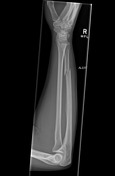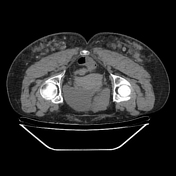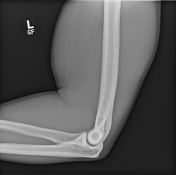21,728 results found
Case
Tibial shaft fracture

Published
29 May 2024
92% complete
X-ray
CT
Case
Nightstick fracture - ulna

Published
13 Dec 2020
82% complete
X-ray
Case
Iatrogenic allogenosis

Published
05 Mar 2024
86% complete
CT
Question
Question 3031
Which of the following skull base foramina is NOT found on the greater wing of the sphenoid
Case
Posterior tibial nerve sheath tumor

Published
12 Oct 2020
80% complete
MRI
Case
Malignant peripheral nerve sheath tumor (MPNST)

Published
27 May 2024
77% complete
MRI
Case
Transient lateral patellar dislocation

Published
28 May 2024
77% complete
X-ray
MRI
Article
Bifurcate ligament
The bifurcate ligament, also known as the Chopart ligament 5,8, is a key stabilizer of the subtalar and midtarsal joints 5,7. It originates from the anterior process of the calcaneus before dividing into two bands that insert into the navicular and cuboid 5-7.
Gross anatomy
The bifurcate ligam...
Article
Malignant peripheral nerve sheath tumor
Malignant peripheral nerve sheath tumors (MPNSTs) are forms of peripheral nerve sheath tumors occurring either de novo or arising from pre-existing tumors (e.g. neurofibromas, schwannomas etc.). Approximately half of such tumors are seen in individuals with neurofibromatosis type I (NF1), in suc...
Article
Gardner syndrome
Gardner syndrome is one of the polyposis syndromes. It is characterized by:
familial adenopolyposis
multiple osteomas: especially of the mandible, skull, and long bones
epidermal cysts
fibromatoses
desmoid tumors of mesentery and anterior abdominal wall
Other abnormalities include:
supern...
Article
Little league shoulder
Little league shoulder is thought to occur due to overuse damage of the proximal humeral epiphysis/metaphysis, seen typically in young baseball players, especially pitchers.
Epidemiology
Although it is most commonly seen in baseball players particularly in pitchers, it also presents in adolesc...
Case
Localized intra-articular tenosynovial giant cell tumor - knee

Published
15 Feb 2018
86% complete
X-ray
Pathology
MRI
Case
Ruptured distal biceps brachii tendon

Published
28 Mar 2024
75% complete
X-ray
Case
Subcutaneous glucose monitor and implanon

Published
28 Mar 2024
82% complete
X-ray
Case
Forequarter amputation for metastatic breast cancer

Published
24 Mar 2015
91% complete
X-ray
Case
Aneurysmal bone cyst of the proximal femur

Published
20 May 2020
66% complete
X-ray
Article
Water lily sign (hydatid cyst)
The water lily sign, also known as the camalote sign, is seen in hydatid infections when the inner endocyst detaches from the outer pericyst, resulting in a free-floating membrane within the cyst.
It is classically described on plain radiographs (mainly chest X-ray) when the collapsed membranes...
Article
Shoulder protocol (MRI)
The MRI shoulder protocol encompasses a set of different MRI sequences for the routine assessment of the shoulder joint.
Note: This article aims to frame a general concept of an MRI protocol for the assessment of the shoulder joint. Protocol specifics will vary depending on MRI scanner type, sp...
Article
Posteromedial ankle impingement
Posteromedial ankle impingement is one of the impingement syndromes of the ankle. It usually follows an injury of the deltoid ligament 1-4.
Epidemiology
It is one of the less common ankle impingement syndromes 2. It is associated with a previous ankle sprain and deltoid ligament injury 1-3.
C...
Article
Garden classification of subcapital femoral neck fractures
The Garden classification of subcapital femoral neck fractures describes femoral neck fracture displacement and aims to assist in clinical decision-making to reduce the rates of non-union and osteonecrosis 1,2,4.
Usage
The Garden classification is the most commonly used system (c.2018) despit...









 Unable to process the form. Check for errors and try again.
Unable to process the form. Check for errors and try again.